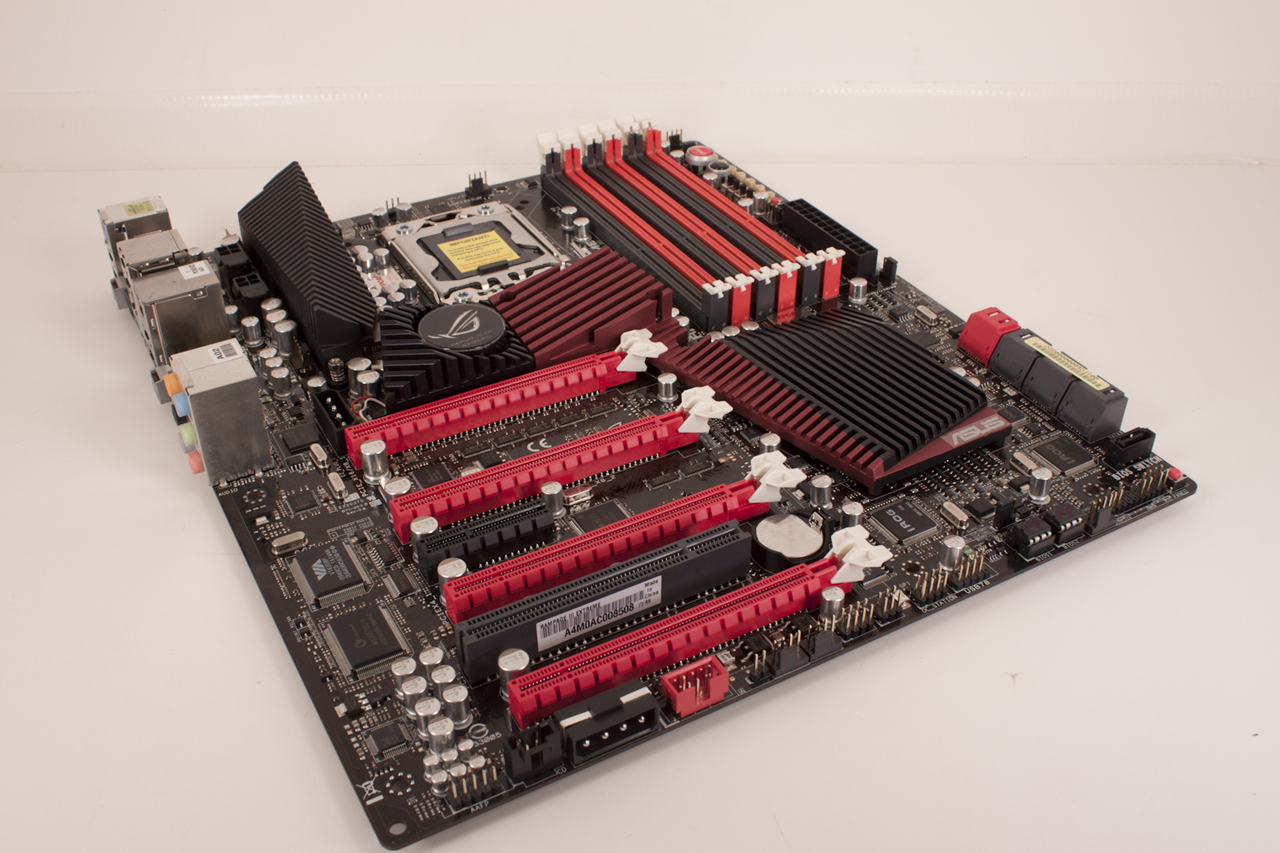Performance testing overview
Our testing is a little different than most. We combine both synthetic and real-world applications to simulate the types of performance common to the individual products. For motherboards this means that we run roughly six synthetic tests and two real-world. We will be expanding the real-world testing in the near future. But there is more to performance than just the raw numbers. As there are multiple components and sub-components on a motherboard there each item can have a distinct impact on the way the product will perform once you get it in your system. It is important to note not only the actual results but what they mean to you as a potential consumer. We will try to give this information to you.
But we do not just cover the performance aspects that are measurable. We also talk about the components that might not have a direct benchmark. These are items like Audio Quality, ease of use and installation.
Section 1 Subsystems
Memory;
Memory performance is very important on a motherboard, especially when you have a CPU with multiple cores and threads. If you have slow memory your cores and threads can become starved for data to execute. To test memory performance we run both Sisoft’s SANDRA and Everest Ultimate. These two combine to not only give us accurate numbers but to validate each other. For testing at stock speeds the memory is hard set to 1333MHz while overclocking testing is done at the highest stable speed for the voltage of 1.65v this is due to the different memory dividers for each CPU. As such, the memory speeds will vary greatly. This means that the overclocked numbers are a little misleading and while they can show a trend are really only included to show if a board has a problem with memory performance at high clockspeeds.
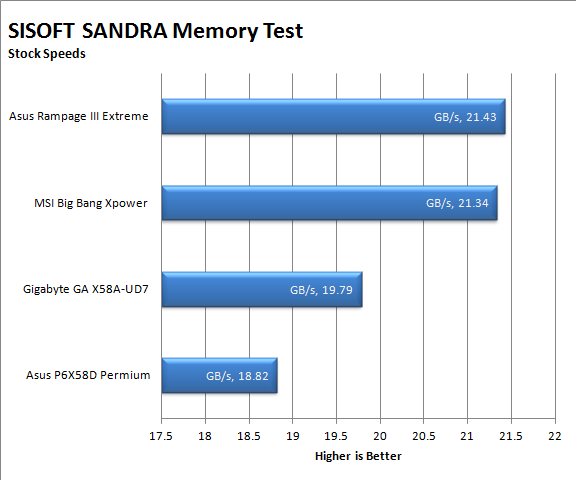 |
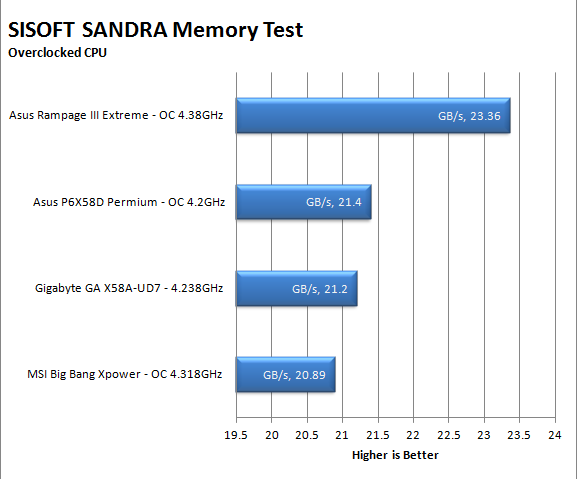 |
Looking at the raw numbers from Sandra we find that the RIIIE pulls off a very nice 21.43 GB/s at stock speeds however this is only .11 GB/s faster than the MSI Xpower. This means that for most applications you are not going to notice much of a difference in performance between these two boards for memory performance. In some memory intensive applications the RIIE will outshine the Xpower but not by much. The overclocked scores tell a different tale and show that the RIIE maintains its stability and performance even with a BCLK of 168MHz.
 |
 |
The Everest numbers show a similar story. You will get good memory performance at both stock and overclocked speeds. This is going to be due to a combination of a good tracing layout and careful coding of skews in the BIOS. The cleaner power regulation does not hurt either.
Drive performance;
Drive performance is also one of the major subsystems that goes to make up the performance of a motherboard. For our testing we use Sandra and Everest again. We only test with single drives for each type of controller present on the motherboard (unless it is a professional product where we will use RIAD 5 and/or 10). We have also begun using a Seagate PS-110 USB 3 external HDD for our USB 3.0 performance. As a side note, we include the overclocked numbers here to make sure (again) that you are not going to see a major drop in performance due to minor instabilities at high clock speeds.
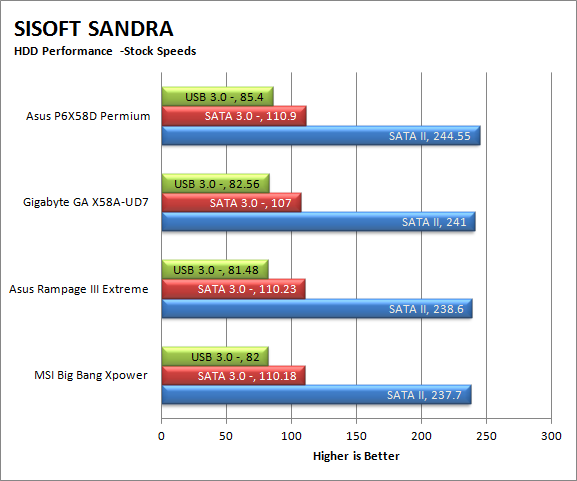 |
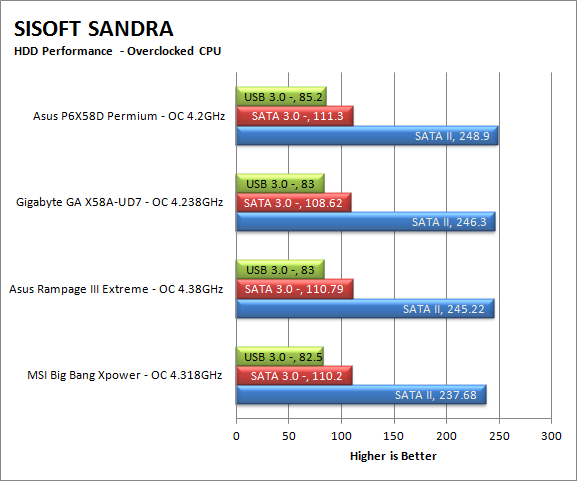 |
Here the raw numbers tell us that the RIIIE is almost in last place. However if you look these numbers you find that it is not that big of a deal. The delta of different between the RIIIE and the P6X58D Premium is less than 6 MB/s; which is not much at the speeds we are talking about (not to mention the 2-3% variance in testing). Sure, you can declare a winner, but in real usage you would be very hard pressed to pick it out of a lineup.
 |
 |
 |
 |
Everest shows us something along the same lines. We do see what could be the cause of the slow SANDRA performance though. Take a look at the buffered read, it is certainly not as high as we would expect and could account for some of the performance lag.
Power;
Power efficiency is another of those misnomers that we get caught up in. We hear about idle states and power gates. But what does that mean to you and I? On the surface having power management that reduces idle power sounds great and can be a benefit to someone that leaves their system on for long periods of time (and inactive) but how a system handles power under load and the delta between the two states is often more important than the idle power usage numbers. We use only P3 Kill A Watt instruments for measuring power.
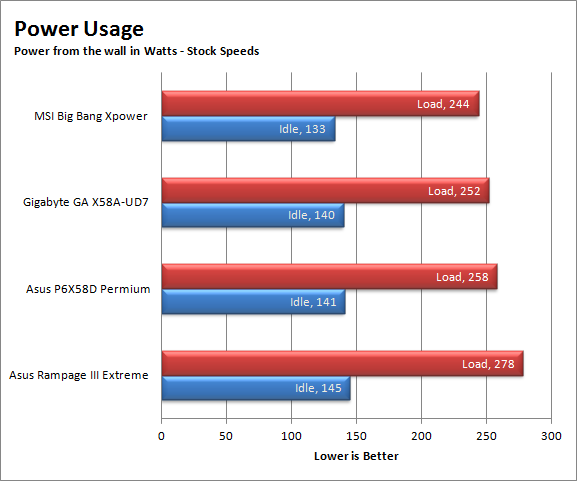 |
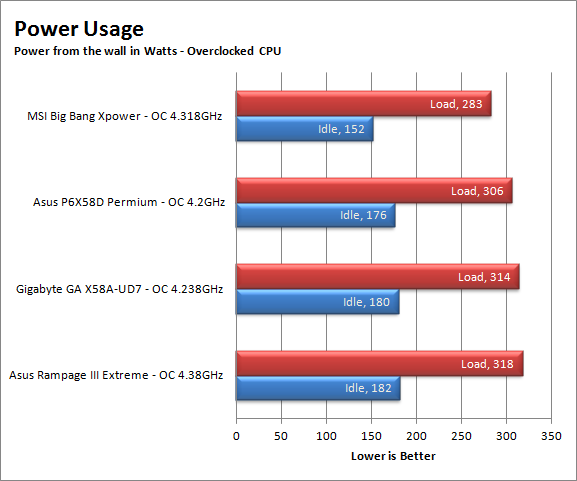 |
Here we see what I was talking about; the Rampage III Extreme is a board that you are going to use. It is not one you would let sit idle and power down. The thing is that at both Stock and Overclocked speeds the RIIIE sucks down the power. At idle is uses, on average 20 Watts more than the next in line. That is quite a bit when you look at it over the course of a few hours. When we kicked the boards into high gear the difference between the RIIIE and the next power hungry product was only about 4 watts.
Cooling (Board Level)
Board level cooling is an important factor in product performance and longevity. Components like the chipset, VRM modules and even capacitors need to be kept relatively cool to prevent failure. As these parts are made of silicon, they have a thermal breakdown threshold; or melting point. At that temperature the actual transistors built into chip will begin to deform and break down. Granted, the threshold is often very high, but you still need to make sure that components stay away from this level of heat for longer product life.
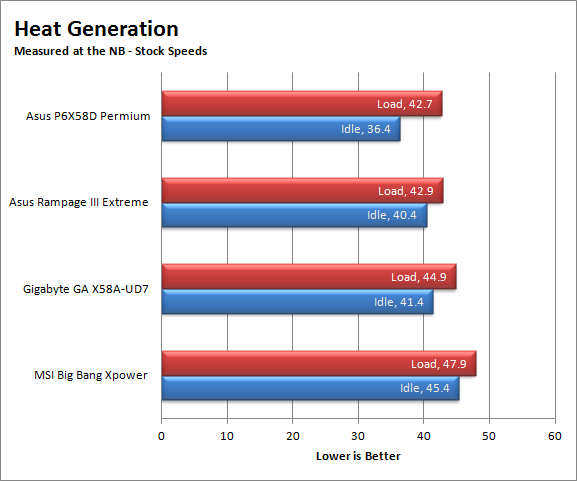 |
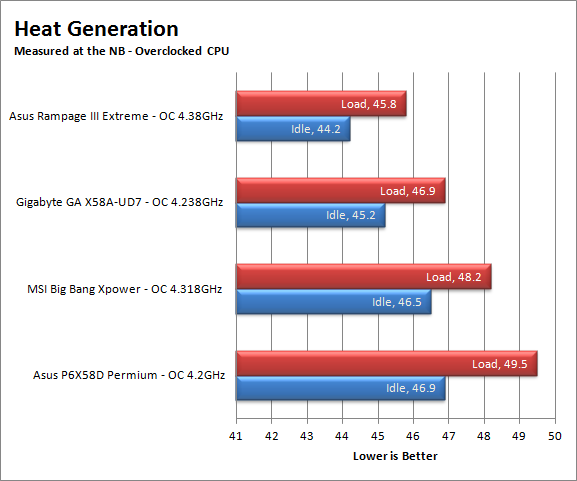 |
Interestingly for an X58 based (enthusiast) product the RIIIE handles heat very well. Again the difference here is not that big, bit it is still good news for product performance and longevity.
Audio;
Audio is highly subjective. What we find pleasing may sound “off” to you. That is always going to the problem with testing audio; results will vary too widely depending on the tastes of the listener. However, there are ways of measuring the audio output with an objective ear. There is also the issue of audio causing performance issues in gaming and video playback. The reason this is a potential source of concern is that all onboard audio CODECs (Compression/Decompression) are CPU controlled. This means that while the audio chip controls the audio levels and effects of the audio the actual work is done on the CPU. Usually this will not be a problem with today’s powerful CPUs. Even the lower and consumer level products can handle high-end audio these days. But again there is the chance that a bad design or software will hinder your system and performance. On the other side the limits of board space, cost, etc will also prevent the level of audio quality you can get from an add-in board. We test all audio parts with three media types, Movie (DVD), MP3 Music, and Gaming. These are pushed to our Tec On model 55 Tube Amp to see if we can detect any signal issues in the reproduction.
On the Rampage III Extreme we did not note any anomalies in the audio reproduction. Surprisingly for an overclocker’s board Asus did go with a fairly good audio CODEC using a RealTek solution. I would like to see them implement the Xonar A200 (or newer) on the ROG boards, but for now the versions they are using seem to be more than good enough.
Networking;
This one is something that is a requirement anymore. If you have a computer, the chances are good (like 99%) that you are also connected to high-speed internet. With this you need a good and solid LAN chip to make sure that your data flows properly out and back.
One of the things that Asus bragged about at CES with this board was that it was going to have an Intel based LAN chip. This is actually a very good thing as Intel does make some of the best (and fastest) GBe LAN products you can buy. However, the upshot of this will still be missed by all but the very upper end of enthusiasts. That is why it is a good thing that this board is marketed to the overclockers and enthusiasts. In terms of performance the Intel GBe controller kept things flowing at a very nice clip. We transferred several GB of files back and forth (about 40GB) without any issues or lags.

